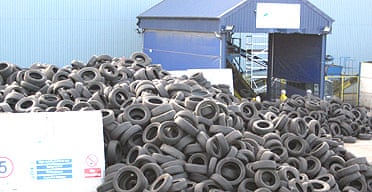The two men work their way methodically through a small mountain of used tyres, feeding them on to a conveyor belt that goes into a machine aptly named the chipper.
The chipper consists of two large rotors with 336 blades. These form oblong blocks small enough to fit into the palm of a hand. Once the tyres reach the top of the conveyor belt and tip into the blades, they are shredded in seconds, reduced to 45mm strips.
Since EU regulations banned the disposal of used tyres in landfills in 2003 as part of a campaign to cut down on waste disposal, chopping up old tyres and using them as an alternative fuel to coal in cement kilns has become a multimillion-pound business.
According to the consultancy Environmental Data Services (Ends), the UK produced 475,232 tonnes of waste tyres in 2004. Of this, 34% was recycled, 26% reused, 15% burnt as a fuel, 7% exported and 6% buried in landfills.
The EU last July extended its ban on using whole tyres in landfills to cover shredded tyres as well. The ban is not complete, however, as it does not apply to old tyres from lorries and buses, which provide significant amounts of waste.
Still, instead of clogging up landfills, most of the waste tyres are now used to make cement. The link between rubber and cement is complex, but cement companies have been burning rubber as part of the cement-making process for 20 years. The landfill ban on tyres significantly accelerated the process.
The tyre-shredding operation at West Thurrock, east of London, belongs to a joint venture between two French companies: Michelin, the world's largest tyre manufacturer, and Lafarge (formerly Blue Circle), the world's largest cement company.
They set up Sapphire Energy Recovery in 2001 as a way to kill two birds with one stone: for Michelin, this was a way of cutting at source the illegal disposal of its tyres through fly-tipping; for Lafarge, it was a means of using a "cleaner" fuel than coal in the manufacture of cement.
Michelin owns 25% of Sapphire; Lafarge owns the rest. In all, the cement and tyre businesses have invested £15m in handling used tyres.
"Sapphire sits in the middle of two different worlds," says Tim Stott, general manager of Sapphire. "The process completely destroys the tyre - Michelin does not want its old tyres ending in fields - while the incineration of tyres helps reduce emissions, as there is no black smoke."
Sitting in the middle of a retail and industrial park that includes the big Lakeside shopping centre, the Sapphire site operates at a relentless pace. Manned 24 hours and closed only on Sundays, it chops up 1,300 tyres -10 tonnes - an hour. It sounds like a lot. But then, some 40m old tyres have to be destroyed every year.
About 100,000 car and van tyres reach the end of their useful life each day, and must be collected and processed for disposal. Sapphire, the largest company of its kind in the UK, has the capacity to process 28m tyres, or 200,000 tonnes, a year.
Once the tyres have been cut down to size, the rubber chips are trucked off to cement kilns. Sapphire trumpets the benefits of using chopped-up rubber for making cement: no waste and cleaner fuel.
But the incineration of rubber material in cement kilns is not without controversy. Cement is made from ground clinker: a mix of sand, shale, limestone and tyre chips that is burned in rotary kilns operating at temperatures of around 1,450C.
The use of cement kilns to burn rubber and other wastes benefits the UK in meeting its obligations under the Kyoto accord and the EU landfill directive because there are fewer emissions of greenhouse gases and less waste needs to be buried.
However, there has been public concern about the possible risks to health of emissions from burning such fuels in cement kilns. Critics point to the nature of some of the materials used and the high temperatures involved, and argue that kilns are being put to a purpose for which they were never designed.
In addressing those concerns, the Health Protection Agency (HPA) in 2004 acknowledged that some cement kilns do produce large amounts of nitrogen oxides. These are gases that may aggravate asthmatic conditions and react with oxygen to produce ozone, also an irritant.
But overall, the HPA gave cement kilns a clean bill of health. It concluded that substitute fuels, such as waste tyres, were no more polluting than conventional ones and, when it came to some key pollutants, were actually less so.
"It is evident that cement kilns, if well managed and maintained, are efficient and effective processes for burning substitute fuels. While changes in emissions do occur, they are modest and site specific," the HPA said.
Yet some local groups are unconvinced. A group in Westbury, Wiltshire, called The Air That We Breathe, chaired by David Levy, has been particularly active in campaigning against a local cement kiln, run by Lafarge, and against all cement kilns burning hazardous waste.
Embarrassingly for Lafarge, the Environment Agency last March said its Westbury site, which burns 250,000 waste tyres, was failing to meet tighter limits on emissions of nitrogen oxides required by the waste incineration directive. The agency ordered Lafarge to submit a plan to bring the site into compliance.
But while Lafarge may have its problems in Westbury, it's all systems go for Sapphire in West Thurrock. As far as Michelin is concerned, Sapphire enables it to fulfil its responsibilities by providing an environmentally friendly way of getting rid of used tyres.
